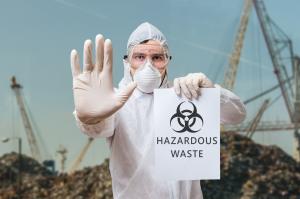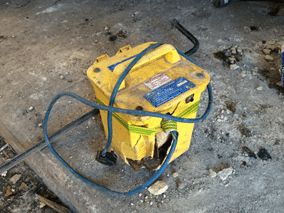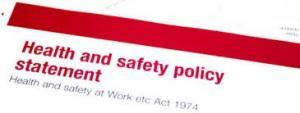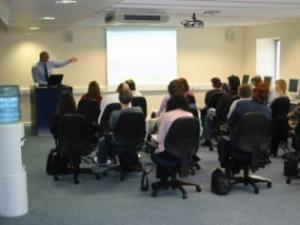Over the last couple of weeks we have had clients asking about Risk Assessments. So I thought it might be worth looking at this topic  again.
again.
Risk assessments can be a ‘pain in the neck’ for many companies; especially the smaller office based business, yet under law they must be completed to ensure the safety of staff and anyone else affected by your operations.
We at The Wilkins Safety Group encourage the owners of smaller offices or office based businesses to undertake their own assessments [follow the guidance given in the Management of Health & safety at work Regs – 5 step program].
It might be necessary in larger organisations or those companies where they do not have the time to implement an effective health & safety system, to utilise the services of an external consultant. We will gladly assist with guidance and hands-on help in undertaking the necessary assessments and audits [makes good business sense].
The HSE Safety officials will take account of the results of the assessments when they carry out inspections – evidence that businesses have taken appropriate steps to manage workplace risk.
Suitable and Sufficient?
The Management of health & safety at work regulations 1999 detail the five steps necessary for undertaking risk assessments.
All Employers have to access the risks to their Employees and any others that may be affected by their work activities.
A Risk Assessment is a careful examination of what could cause harm to people, so that suitable control measures can be put into place to prevent harm. The objective quite simply is to ensure that no one gets hurt or becomes ill due to work activities.
A recommended method of completing a Risk Assessment is given in the publication ‘Risk assessment A brief guide to controlling risks in the workplace’ issued by the HSE. The following procedure broadly follows the HSE’s recommended methodology.
Hazard and Risk
A HAZARD is Something with the potential to cause harm (substances or machines, methods of work and other aspects of work organisation).
Risk is the likelihood that the harm from a particular hazard is realised. The extent of the risk covers the number of people affected and the consequences for them. Therefore risk reflects both the likelihood and severity of the harm.
Look for the hazard
Decide which hazards are significant i.e. can cause serious injury or death. Examples of hazards include uneven floors, obstructions on floors such as cabling, which could result in slipping/tripping; badly stowed stock falling from shelves, hot/cold surfaces, leaking chemicals, electrical defects, hazardous substances such as acids, heavy boxes which must be lifted, defective ladders, poor lighting, ventilation or heating.
Decide who might be harmed and how
People who might be harmed include full or part-time employees, contractors, security personnel, cleaners, members of the public, etc.
Then think of ERIC
Eliminate
Can you eliminate the risk? For example if you have a delivery to your depot, can it be moved by a forklift truck, thereby eliminating any manual handling risk.
Reduce
If you are unable to eliminate the risk, you should see if you can reduce the risk. So, sticking with the manual handling of the delivery where you haven’t got a forklift, can you break the load into smaller loads that can be easily carried?
Isolate
If the electrical power has been turned off to allow you to do work safely, it is essential that the power stays off until you have finished work. A good way is to have the only key to the switch or a locked room or cabinet containing the switch. Remember, if you remove a fuse, another one could be inserted in its place, and people ignore notices.
Control
Having decide on your approach to the risk, you need to control this approach. This includes looking at the individual capabilities of your workers, the provision and use of PPE, giving everyone involved the correct training and information. And monitoring the process to see that it all goes as planned.
Record the findings
Best practice dictates that all Risk Assessments are written down and recorded for future reference; this is mandatory where five or more people are employed. Risk Assessments can also be used as a guide to improving working practices.
Review the Assessment on a regular basis and revise it if necessary
A date should be set for the review of the assessment. The review must check that the precautions and controls for each hazard still adequately control the risk.
Employees must be made aware of any Risk Assessment and the control measures that affect them. Where necessary training or appropriate PPE will be given to obviate the risks identified. A plan should be prepared to eliminate any Hazards as far as reasonably practicable.
The Wilkins Safety Group can provide the necessary tools and assistance, including formatted Risk Assessment forms to assist you.
Quick guide provided by us for you to consider.
Although the main hazards experienced at work are normally in areas such as Fire, Electricity and Specialised Work equipment, [all covered by individual Risk Assessments]. A major cause of injuries are simple things such as Slips, Trips and Falls, bad posture whilst lifting weights [manual handling] and upper limb disorders caused by working at badly set out computer workstations [DSE Regs].
To help you complete a suitable and sufficient Risk Assessment of your premises, we have highlighted some important areas for you to consider:
- Ensure all work equipment is in good order and free from hazardous conditions such as: – mounted on unsafe shelves or surfaces, sharp edges, hot/cold
 surfaces, excessive noise, unguarded moving parts, etc. In addition ensure that, where appropriate, the equipment is maintained and tested by a competent person at regular intervals as recommended by the manufacturer.
surfaces, excessive noise, unguarded moving parts, etc. In addition ensure that, where appropriate, the equipment is maintained and tested by a competent person at regular intervals as recommended by the manufacturer. - Ensure that lighting is sufficient and adequate for the purpose. A combination of natural and artificial lighting is preferred whenever possible. It is also important to ensure that Display Screen Equipment is used with low glare lighting.
- Emergency lighting [tested as required by a competent person] is often essential to assist evacuation in the event of normal light failure.
- The premises should be heated to a reasonable minimum temperature, 13-16 degrees C where manual work is carried out; offices generally require a higher temperature 18-20 degrees within one hour of work starting, [there is currently no upper limit]. The heating system should be regularly maintained and tested to ensure it is safe and does not emit offensive or hazardous fumes. A thermometer should be located in an easily visible location.
- Whenever possible the premises should be ventilated by fresh air or by suitable mechanical means. Poor ventilation will lead to temperature and humidity problems that can result in uncomfortable and unhealthy working conditions.
- All passageways, exits and stairs should be free from obstruction and allow free access/egress to public areas. Floors should also be checked for uneven surfaces, trailing electrical cables and any other objects that could cause an accident or injury. It is also important to ensure exit routes are clearly marked and handrails are provided on all stairs.
- Ensure employees have sufficient workspace and there is no overcrowding.
- All open shelves and cupboard shelves should be strong enough, not overloaded and suitable for the purpose. Filing cabinets should be fitted with and anti-tilt mechanism and a device to allow only one drawer at a time to be opened.
- Ensure that there are sufficient and suitable rest areas away from the work areas.
- Drinking water should come from either a mains supply or bottled water. It is also important to ensure that if drinking water is taken from the mains supply, it is not contaminated with lead from old service pipes. In premises where stored water is available the tap for drinking water should be labelled as such.
- Any work equipment that emits heat or other potential hazards e.g. photocopier, should be situated in a well-ventilated area to prevent build-up of hazards such as ozone. Equipment of this nature should never be situated in a small confined room with little or no ventilation.
- Any spillage should be cleaned up immediately. If a hazardous substance is spilled, special spill procedures with the appropriate PPE must be used, together with special spill kits if appropriate. Care should be taken that the waste materials are disposed of properly.
- All electrical appliances such as work tools such as drills and saws, but also appliances such as microwave ovens, kettles, toasters and vacuum cleaners should be tested on a regular basis by a competent electrical person. Frequently used electrical equipment should be visually inspected before use.
- Where possible separate toilets should be provided for male and female employees. If only one toilet is available it must be lockable from the inside. Hot and cold running water and hand cleanser should be provided, together with suitable drying material or equipment.
- Showerheads and taps should be regularly cleaned and disinfected to prevent the spread of Legionella. They must also be flushed 3 times a week if not being regularly used. For Example: in schools during holiday periods or holiday camps in the closed months.
- Ensure the no-smoking policy is adhered to, in order to reduce the risk of fire.
- All visitors to the premises should be signed in and escorted to a safe reception/public area via a safe route to await their appointment. Where applicable the Company Safety Policy and Rules for Visitors should be made available to them.
- If there is a threat of violence to employees, ensure that they are aware of the Company’s Violence Policy.
- All employees must be familiar with the Company’s Health and Safety Policy and procedures. Employees must receive suitable and sufficient training to ensure their safety and well-being at work.

If you would like any further help or support, please please contact us by phone 01458 253682, email or via our Facebook page or by Twitter.
Introducing New Services in 2019
During 2019 we aim to introduce new services to our clients, through our web site. These will include:
E-Learning
Health and Safety e-Learning is a simple way to provide training solutions to meet the training requirements of businesses large and small. With Health and Safety training as our main focus we are looking to offer Compliance & Soft Skills courses and a fully SCORM compliant LMS.
Webinars
Webinars allow large groups of participants to engage in online discussions or training events and share audio, documents or slides – even when they’re not in the same place as the meeting host or in the same room where the event or presentation is taking place. So, we are looking into the possibilities of providing Webinars on Health & Safety topics to our clients.
We stress that we are still looking at how we can develop these so keep an eye on our website and these newsletters for more information as things progress. – Are there any other services you would like to see?
Taunton & Somerset CPD Group at The Exchange House Taunton
Please remember that we now run these CPD events at the Exchange House, 12 – 14 The Crescent, Taunton TA1 4EB on a fortnightly basis
The next of the CPD events is listed below.
As previously requested, if you could let us know whether or not you can attend it would be greatly appreciated. Also, if you would like to give a talk, or know of somebody who would, please contact Jon at [email protected]
Our next Seminar will be on Wednesday 5th December 2018. Could you please arrive by 12:30pm prompt.
Our speaker for this one is Charlotte Markey of GreenBlue Urban will talk about Designing Trees into the Urban Environment
If you haven’t already booked your place, or if you are not on the CPD Seminar mailing list but would like to be please drop Jon an email and he will deal with your request.
As per our last one if you could let Jon know whether or not you can attend within 7 days of receipt of his email, it would be greatly appreciated.
Contact Details [email protected] 07831 714199 or 01458 253682
*Early notice of 19th December meeting. Craig Huxley of Triflex (UK) Ltd will talk about Creative Car Parks
For more details about these and the other forthcoming CPD talks please see cpds for the rest of 2018.
Training Courses
Under the Health & Safety at Work Act 1974 all relevant associated legislation, companies have a duty to train all their employees in health and safety matters.
THE WILKINS SAFETY GROUP are professional health & safety trainers.
As part of our services we provide a full range of Health & Safety courses at The Taunton Racecourse in Somerset which provide the latest in training facilities including multimedia projectors and large screen videos. They also provide delegates with a relaxed environment in which to learn, excellent food and ample car parking.
Alternatively, we can run most courses at your premises or another venue in your area, to suit your requirements.
How do we teach?
Our training style is informal and interactive, with use of syndicate work, case studies, discussion sessions and role-play. Videos are often used to enhance points being raised.
We believe that delegates gain the most from a course when they are relaxed, and our trainers and staff endeavour to ensure that this is made possible.
The next batch of courses will be in 2019
But remember we are still available for running “In House” courses and are looking to add new training courses to our list.
If you have any questions about these courses or any other training or would like us to run a particular course for you, call Jon Wilkins of the Wilkins Safety Group on 01458 253682 or email him at [email protected]
